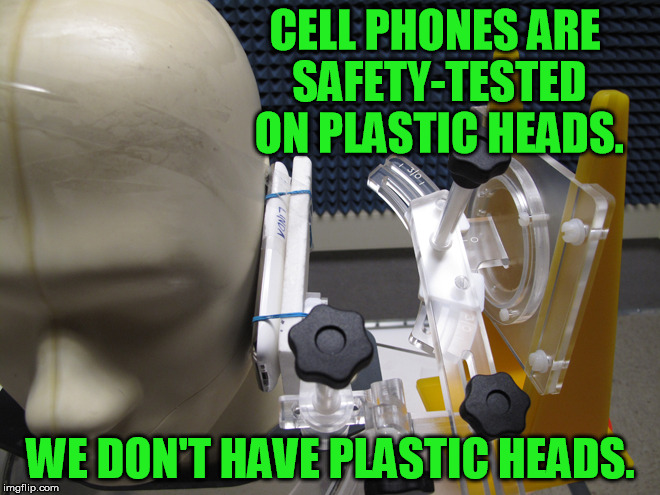Last August the Chicago Tribune published a report that 11 smartphone models exceeded federal RF safety levels. This led to Fegan Scott law firm starting a class action lawsuit. Two lawsuits have also been filed against the Federal Communications Commission (FCC) because they refuse to provide adequate RF exposure safety guidelines, limits, and testing (see 1, 2). This puts us all at risk for exposure related conditions and illnesses (see 1, 2, 3, 4, 5) – especially children (see 1, 2). In fact, no “safe” level of cell phone radiation has still been scientifically determined for children or pregnant women.
Regardless, companies continue to make and market smartphones and other wireless devices to everyone – including children (see 1, 2, 3, 4) – even though tech industry insiders tend to NOT give them to their own kids.
Adding insult to injury, telecom companies have been warning their shareholders for many years that they may eventually be held liable for harm from their devices and transmitters (see 1, 2).
Thanks to Scientists4WiredTech for reporting more about this:
RF-EMR Exposure Test: iPhone 11 Pro Exceeds FCC Limit
The test, conducted by Penumbra, also highlights problems with the U.S. FCC’s wireless safety regulations
Adapted from an article by Michael Koziol | Original IEEE Spectrum article here.
A test by Penumbra Brands to measure how much radiofrequency energy an iPhone 11 Pro gives off found that the phone emits more than twice the amount allowable by the U.S. Federal Communications Commission.
The FCC measures exposure to RF energy as the amount of wireless power a person absorbs for each kilogram of their body. The agency calls this the specific absorption rate, or SAR. For a cellphone, the FCC’s threshold of safe exposure is 1.6 watts per kilogram. Penumbra’s test found that an iPhone 11 Pro emitted 3.8 W/kg.
Ryan McCaughey, Penumbra’s chief technology officer, said the test was a follow up to an investigation conducted by the Chicago Tribune last year. The Tribune tested several generations of Apple, Samsung, and Motorola phones, and found that many exceeded the FCC’s limit.
Penumbra used RF Exposure Labs, an independent, accredited SAR testing lab for the tests (The Tribune also used the San Diego-based lab for its investigation). Penumbra was conducting the test, which also included testing an iPhone 7, to study its Alara phone cases, which the company says are designed to reduce RF exposure in a person.
McCaughey clarified that Penumbra supplied RF Exposure Labs with one iPhone 7 and one iPhone 11 Pro for the tests — phones the company had purchased off the shelf. He attributed not testing more phones to the cost of purchasing multiple iPhones. While the Tribune and Penumbra both used off-the-shelf phones, the FCC largely tested phones supplied by the manufacturers, including Apple.
S4WT Comment: Hmmmm . . . why did Apple do that? Consumers buy their phones off the shelf.
Joel Moskowitz, a researcher at UC Berkeley who studies the health effects of wireless radiation, points to one of two possibilities. According to him, one option could be that there’s a systematic problem with RF Exposure Lab’s testing methods. Alternatively, he says, when Apple provided phones to the FCC for the follow-up investigation, “it would be easy to dummy the phone with a software update” and ensure it didn’t put out enough power to exceed the SAR limit.
Apple declined to comment on the record for this story.
There may be uncertainty in which results carry weight, but McCaughey and Moskowitz both agree that the FCC’s RF exposure testing is woefully out of date. McCaughey points out that the limits were set well before the invention of smartphones, and reflect what the FCC deemed safe 25 years ago.
“The FCC limits are over 20 years old,” says McCaughey. “Some might argue that the limit is antiquated at this point.”
The SAR limit is solely about a phone’s ability to heat tissue — essentially, the power is limited to 1.6 W/kg to ensure that no one is burned by using their phone.
S4WT Comment: Hmmmm . . . we wonder why? SAR is Specific Absorption Rate (in Watts), which only evaluates the rate of exposure, not the total exposure over time, which is measured by SA or Specific Absorption (in Watt-seconds). No other toxin is evaluated by the rate of exposure. Every other toxin considers the total dose of toxin. Is measuring only the rate of exposure and not the total exposure to a toxin scientifically sound? No, it is not. We are arguing about nonsense. SAR is irrelevant nonsense.

